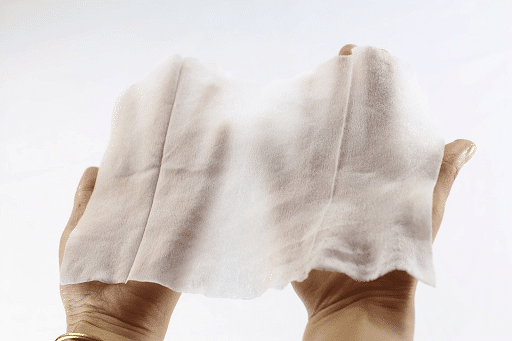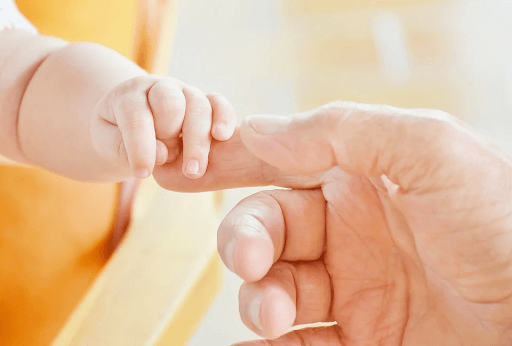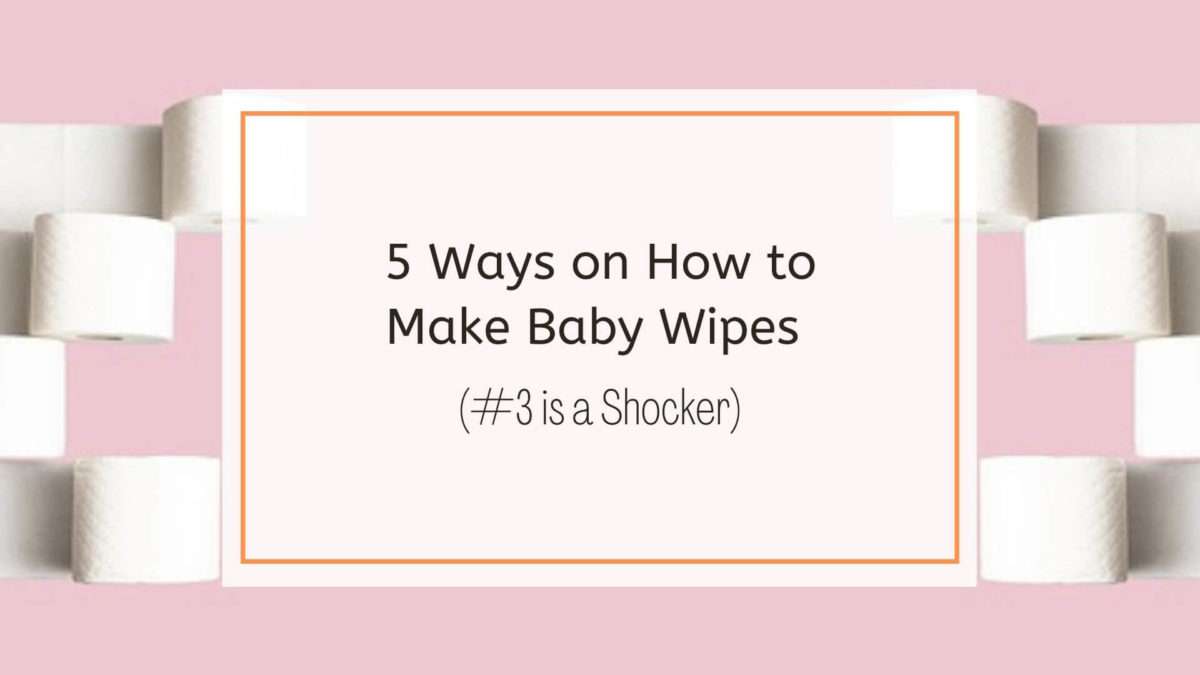
Baby wipes, paper towels and alcohol-based hand sanitizers are one of the few items which shouldn’t be cut off from the grocery list. These personal care items help fight the spread of the Covid-19 bacteria by keeping the hands and surfaces clean.
Baby wipes in particular, used to be indispensable for parents and for those caring for adults. But today, more users find portable disinfectant wipes so essential for keeping things clean whenever outside.
With the occasional encounters of empty shelves, abominable prices on Amazon and the need to be more thrifty, who wouldn’t want inexpensive, durable wet wipes that you can make at home?
In this post are 5 ways on how you can make baby wipes with your own hands!
Contents:
-
- Choosing Your Materials
- 1st Way: How to Make Baby Wipes Out of Paper Towels?
- 2nd Way: How to Make Cloth Baby Wipes?
- 3rd Way: Can you make baby wipes into disinfectant wipes?
- 4th Way: How to Make your Own baby Wipes for Sensitive skin
- 5th Way: How to Make Flushable Wet Wipes?
- How Long are Homemade Baby Wipes Good For?
- How to Make Baby Wipes Wet Again
Choosing Your Materials
In all the recipes in this post, these are the most basic baby wipe DIY materials you need:
- Baby shampoo or Castile Soap – This provides structure to your soaked paper towel, and at the same time, provides a clean feel on the skin. (Dr. Bronners is a good product to start off)
- Oil – A little oil can help moisturize your skin.
- Essential Oils – These add an extra scent and soothing feeling, but is optional especially if you have a sensitive skin.
- Distilled Water or boiled water cooled at room temperature – distilled water is preferable because it contains no impurities like tap water. But if you don’t have access to distilled water, you can boil the tap water and let it cool to a warm temperature.
- Airtight Container or Baby Wipes Dispenser– Choose a container with an airtight lid and a wide opening. In this way, you can easily access and dispense each baby wipe while avoiding air entering the container. You can use a Glad or Rubbermaid storage container
- Paper Towels – The paper towels should be durable and firm enough to stay intact even when soaked.
1st Way: How to Make Baby Wipes Out of Paper Towels?
Want to know how to make baby wipes out of durable toilet paper? Here’s the simplest way to do it!
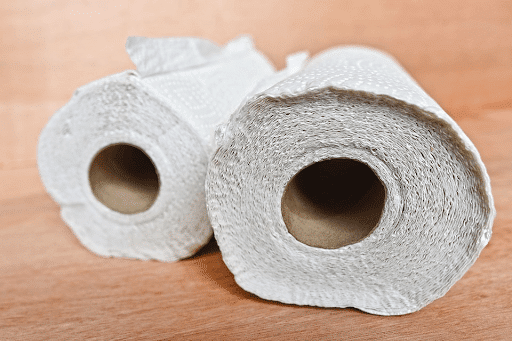
Credit: Pixabay
Duration
- 15 minutes
Materials
- Paper towel
- Storage container or tupperware
- 2 warm cups distilled water
- 2 tablespoons liquid soap
- 1 tablespoon food-grade oil
- Essential oils lavender or tea tree extract (optional)
Steps:
- Using a jagged blade, cut the paper towel in half.
- Put one half in a wide-mouth container or tupperware.
- Use 2 cups of warm distilled water. You can use boiled tap water but take note, tap water may have microbial or organic impurities so it’s more sanitary to use distilled water.
- Put two (2) tablespoons of liquid soap and one (1) tablespoon of oil in the water.
- Mix thoroughly.
- You can also add 1 drop of lavender or tea tree extract essential oil to make it an antibacterial solution.
- Pour the solution in the paper towels. Close the container and let the paper towel soak in the solution.
- Open the lid and remove the cardboard roll at the center.
- Use your homemade paper wipes!
Video Tutorial
If you prefer a video, this is the best DIY Baby Wipes we’ve found:
2nd Way: How to Make Cloth Baby Wipes?
Reusable baby wipes are made from cloth. Cloth wipes are often branded as eco-friendly because they cut down landfill waste.
Although cloth wipes are easy to make, you need a little sewing to make it more durable. You can do this with manual hand stitching or using a sewing machine if you know how.
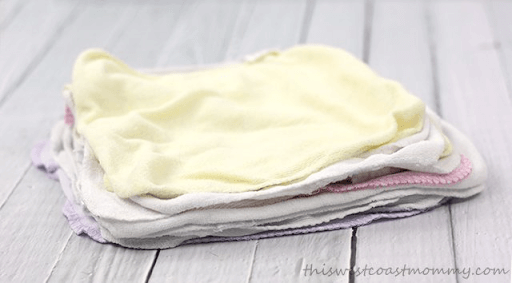
Image credit: This West Coast Mommy
Duration
- 20 minutes
Materials
Here are the materials you’ll use to make reusable baby wipes:
- Baby washcloth (you can also use organic cotton flannel or bamboo fabric)
- Sewing materials or sewing machine
- 2 cups of warm distilled water
- 2 tablespoons of baby oil
- 2 tablespoons baby shampoo
- A few drops of lavender or chamomile essential oil (optional)
- Wet wipes container and a separate container for keeping used reusable wipes
Note:
- Be sure to use non-toxic oil or soaps for babies or children with sensitive skin.
Steps
- Cut the baby washcloth into 8×8 squares.
- Lay 2 pieces of fabric on top of the other and stitch them together around the edges. Set aside in its container
- In a container, mix the water, baby wash or shampoo, baby oil and essential oils. You can use a shake bottle to pour the content in and shake it well.
- Pour in enough solution into the fabric, just enough to keep it soaked.
- When using the wipes, make sure to store the used or dirty wipes in a separate container. You can then wash it later on.
- Wash the used cloth and sterilize it. You can use the same solution to soak the newly washed wipes in.
Video Tutorial
Here’s a video on how to sew reusable cloth wipes:
How to Make Cloth Wipes Without Sewing?
Have no sewing skills? You can simply choose a heavier but soft fabric to make no-sew reusable wipes. Blankets, old pajamas or flannel will do. Just make sure it’s not flimsy or worn out on the edges so it won’t make a mess.
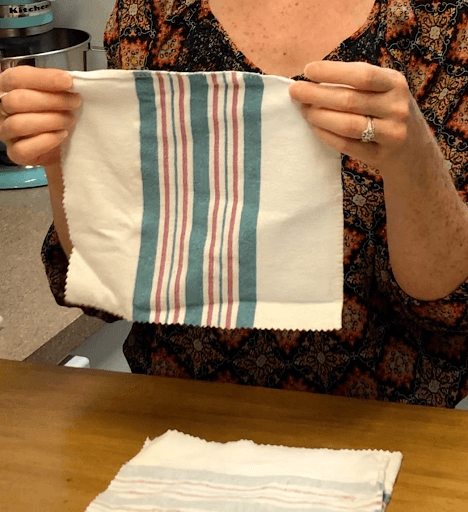
Source: The Crunchy Ginger
Here’s a good video on how to DIY reusable cloth wipes without sewing.
Related:
3rd Way: Can you make baby wipes into Disinfectant Wipes?
Because of the COVID-19 outbreak, people have turned to disinfectant wipes and antibacterial wipes for sanitizing surfaces clean. By adding isopropyl alcohol to your baby wipes, you can, produce a disinfectant sanitizing wipes.
You can use disinfectant wipes for contaminated areas such as restaurant tables, chairs, shopping cart handles, steering wheels, car handles and doors handles. Disinfectant wet wipes contain alcohol, which means you shouldn’t use it on the baby’s sensitive skin, or on anything that can be damaged by the substance.
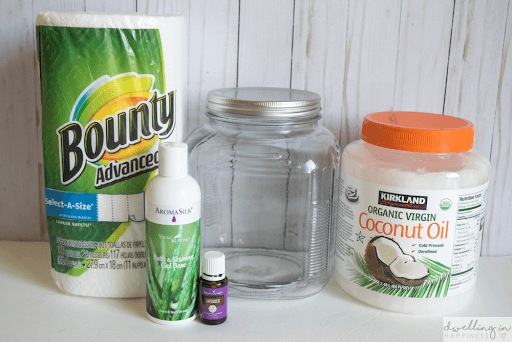
Image Credit: Dwelling in Happiness
Duration:
- 20 minutes
Materials
To make DIY Disinfectant Wipes from baby wipes, you need the following materials:
- 1 pack of baby wipes
- 1 cup of 80% to 90% isopropyl alcohol or rubbing alcohol
- A few drops of essential oil (optional) such as tea tree extract, lemon, peppermint, lavender, orange oils or eucalyptus
Steps:
- Maintain the baby wipes in their original packaging.
- Pour the isopropyl alcohol and essential oil in a mixing bowl or bottle
- Shake well
- Pour the solution on the baby wipes.
- Soak it well and make sure each layer is coated with the alcohol solution.
- Viola! You now have disinfectant wipes from your baby wipes.
Related:
Are DIY Disinfectant Wipes Safe for Kids?
Care should be taken when using DIY disinfectant wipes around children. Accidentally ingesting isopropyl alcohol can cause blurred vision, dizziness, slurred speech and intoxication. When ingested in large amounts, it can cause kidney failure, blindness, liver or brain damage or even result in death.
Everytime you use your DIY disinfectant wipes to clean your child’s toys or objects near your child, you must wipe it with water. You should also keep the room well-ventilated when disinfecting surfaces with alcohol-based cleaners.
Related:
- What Happens to Your Child If He Drinks Hand Sanitizer?
4th Way: How to Make Your Own Baby Wipes for Sensitive Skin
Is your skin sensitive? Follow this baby wipes for a sensitive skin recipe to avoid rashes and skin irritation.
Duration:
- 15 minutes
Materials
- 1¼ cups of warm distilled water
- 1 teaspoon of organic, unrefined, virgin coconut oil
- ½ teaspoon of baby shampoo
- Paper towel roll (Halved)
- Baby wipes dispenser or container
Steps
- Cut the paper tissue roll in two and keep the other half.
- Put the half-roll into a container leaving the cardboard tube still attached.
- Mix the water, coconut oil and baby wash together. Blend it well.
- Pour into the roll and close the lid
- Wait for about half an hour until the paper towel soaks into the solution.
- Pull out the cardboard.
- Viola! You can now use your baby wipes for your baby’s sensitive skin.
5th Way: How to Make Flushable Wet Wipes?
For the record, “flushable” wet wipes don’t flush the way toilet tissues do and it’s discouraged to to flush them down the toilet. You can, however, flush them one at a time to avoid toilet clogging.
In the industry, the trick in manufacturing flushable wipes is to use less synthetic fibers. To test the “flushability” of these products, a wet wipes manufacturer tests if the wipes can flow through a domestic pipework. It should not clog sewage pumps and should disintegrate easily when subjected in a variety of water treatment scenarios.
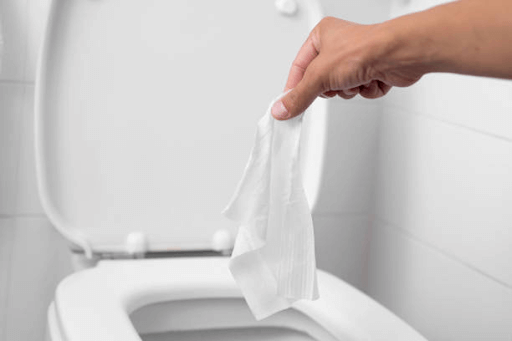
Source: iStock by nito100
Now a lot of people may find it inconvenient to use commercial wet wipes when “dropping the bomb”, simply because you cannot flush most wet wipes. They are often labeled with “do not flush” at the back of its packaging, or you’d see a picture of a toilet crossed out.
If you want to make DIY flushable wet wipes, there are a few tricks you can do to make it more flush-friendly. Note that you can only flush wet wipes one or two at a time to avoid sewage problems.
What You’ll Need
- Use a biodegradable paper towel or less “thick” paper towel. You can use Kirklands Paper Towels
- Container
- ½ teaspoon castile soap/baby wash
- 1¼ cups of warm distilled water
Steps
- Cut the paper towel in two and keep the other half.
- Mix the baby shampoo or castile soap in distilled water. Blend well.
- Pour the soap solution onto the wet wipes until it’s entirely coated.
- Viola! Now you have flushable baby wipes you can use in your bathroom.
How Long are Homemade Baby Wipes Good For?
Storing your disposable homemade wipes should be in an airtight container to preserve its use. Take note that DIY baby wipes use natural and organic oils and there are no preservatives in it. This means the wipes the safest length of time you can use your wipes is less than a month. If you notice molding, stop using the wipes and throw it away.
You can store unused wipes in a refrigerator to lengthen its life. Keep it in an airfree container to preserve its freshness.
How to Make Baby Wipes Wet Again?
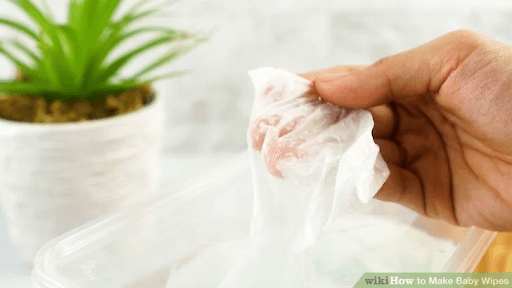
Image Credit: Wikihow
If you notice your homemade baby wipes becoming dry, you can rehydrate it with warm water. Here are the following steps.
- Boil the water for 2 minutes.
- Let it cool up to the room temperature.
- Pour the water into the wet wipes container, just enough to soak and dampen it.
Wrapping Up
Baby wipes being a portable and convenient product to use and disinfect the skin and surfaces with makes it a highly sought product today. Changing your baby’s nappy, keeping your hands clean and cleaning your face are all conveniently done with wet wipes. We hope you were able to find the best way on how to make baby wipes in this post.
RELATED:

